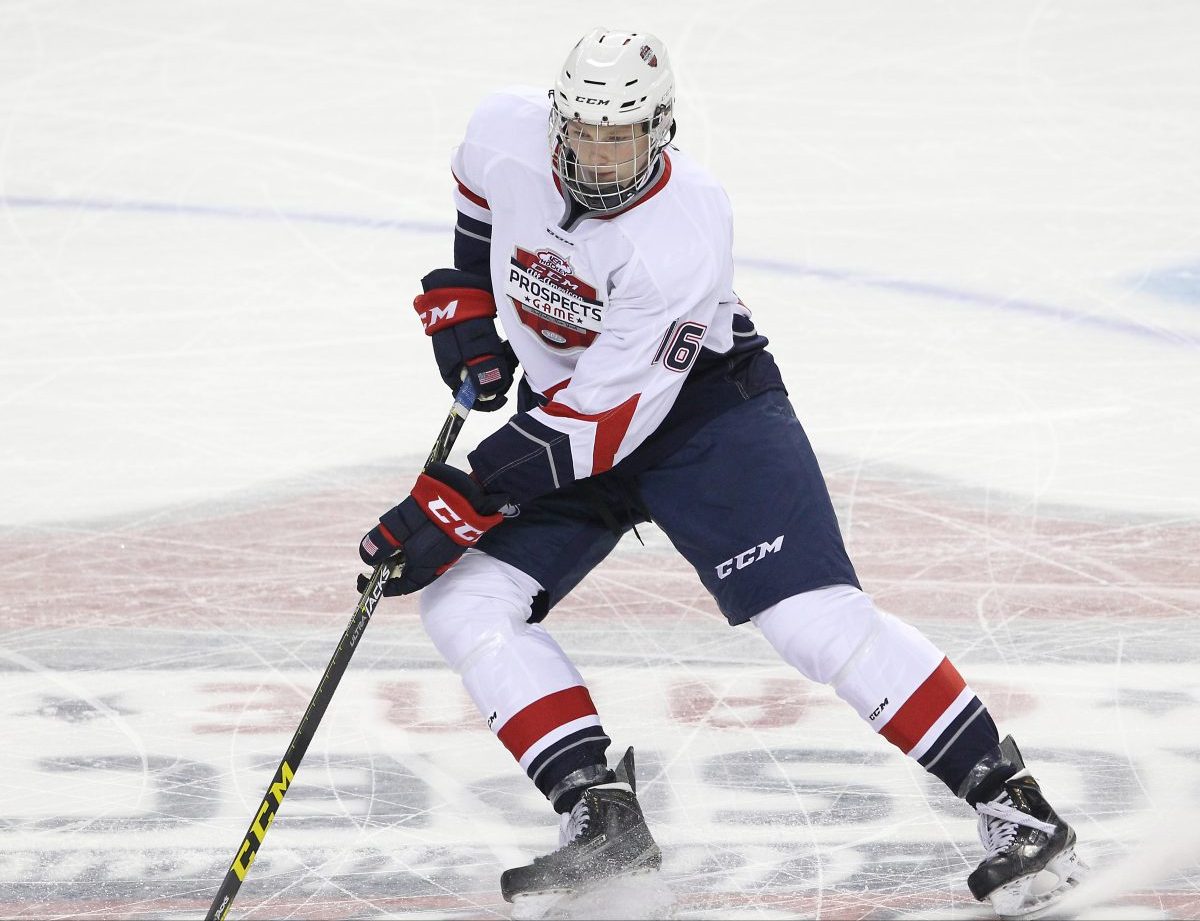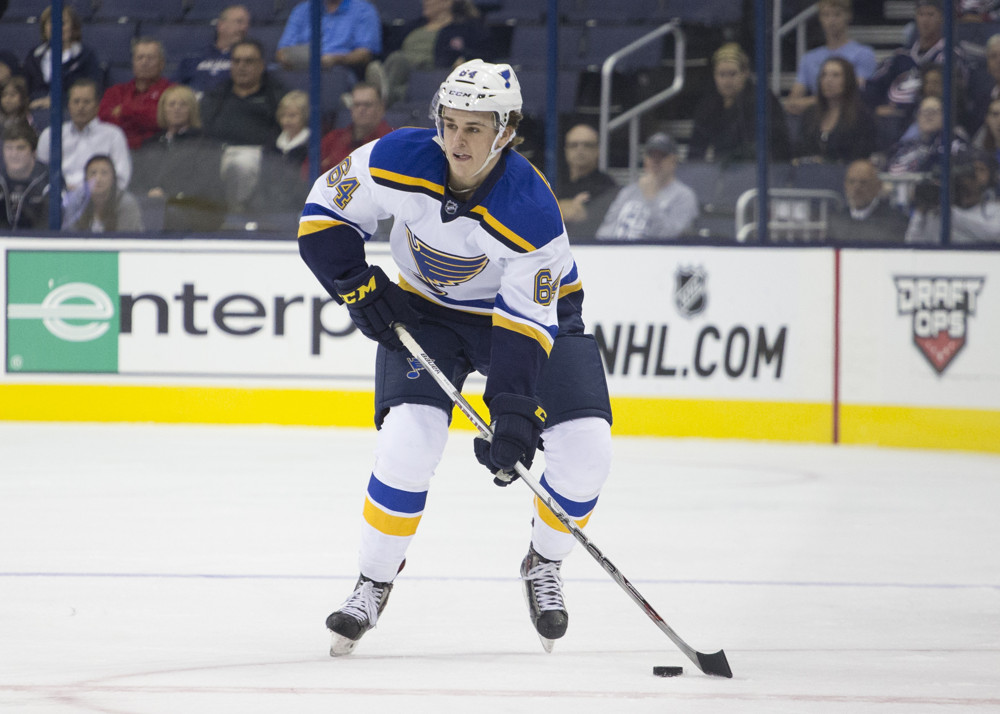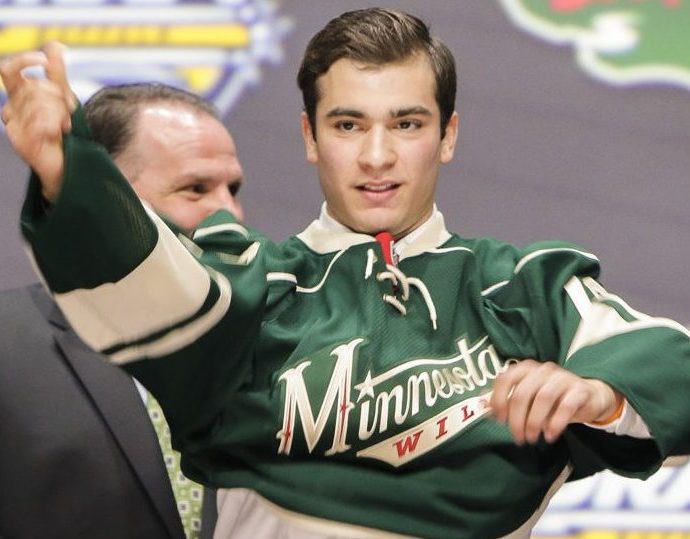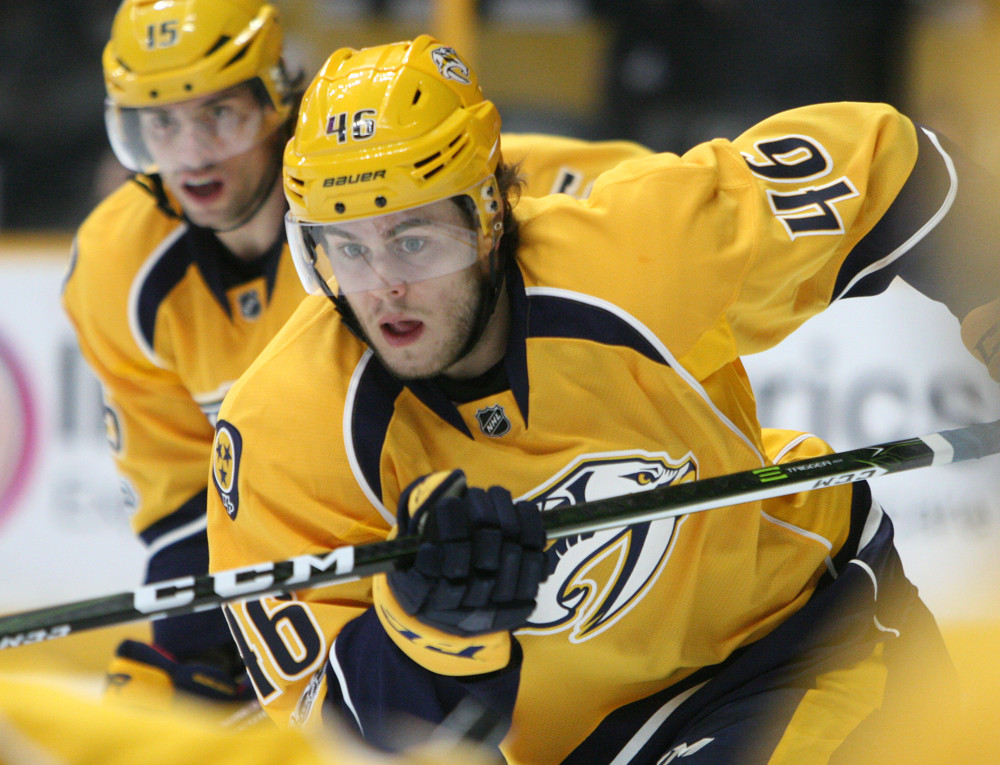
How about another themed article? Or four? Over the next four weeks, this column will be devoted to running down the various divisions. Starting this week with the Central Division, I will profile the development of one affiliated prospect (AHL or NCAA) per team in the division who has caught my eye in the first half or so of the current season. I don’t want to be a slave to alphabetism, so I will kick things off here with the Dallas Stars and their most recent first round pick, Riley Tufte (Dallas, 1/25, 2016 – LW, Minnesota-Duluth (NCHC)).
Drafted largely on the strength of his production at Blaine High School in Minnesota, where he scored more than three points per game, as a giant towering over his peers both physically and as measured by skill. There were legitimate concerns with Tufte as a prospect due to his more meagre totals with Fargo in the USHL, where he contributed only 14 points in 27 games. (As a side note, Casey Middlestadt of Green Bay and Eden Prairie High School will not elicit this concern as he tore up the score sheets everywhere he played.)
In spite of the worries about his level of competition, Tufte graded out well in the eye test. Not only was he absolutely massive (6-5”, 205), but he was a plus skater, and not in the pejorative “for his size” way. He would have graded well for his wheels even if he were five inches shorter. He also received praise for owning a pair of soft hands, allowing to create nice plays in small spaces. Did I mention he was also huge? He’s huge.
Now a freshman with number one ranked Minnesota-Duluth, Tufte has been reigniting those concerns about being able to beat up on poor competition while taking a secondary role among bigger, more talented kids. I do not want to sugar-coat this in any way, but he failed to register a single point for the Bulldogs in his first 14 games. He was not a complete non-factor, compiling 21 shots on goal, suggesting some bad luck in his donut ring, but zero points is zero points.
He remains a physically imposing player, but he does not play a very imposing, or physically dominant game. He can be tough to dislodge from a given spot in the offensive zone, but that is roughly the extent of his assertiveness on the ice. In many scenarios, the game seems to be moving too fast for him to keep up. Not so much as a skater – he still shows plus acceleration and a decent top speed, but rather that he is all too often behind the play instead of driving it. When he has the puck, he can show some sparks with his ability to handle it, but the concern is essentially his ability to read the game at the pace necessary to play a primary role.
Thankfully for Tufte, the Bulldogs and the Dallas Stars, he has started to turn things around. He finally picked up his first point, an assist, in UMD’s first post New Year’s break game. In his six games since the break, he has six points, including three goals last weekend against reining the NCAA champs from North Dakota. If Tufte has truly turned a corner, the Bulldogs will be a fearsome squad in the run-up to the NCAA tournament. I’ll be watching.
Samuel Blais (St. Louis, 6/176, 2014, LW, Chicago (AHL))

An eighth round pick in the QMJHL entry draft, he had only played in 25 games with Victoriaville, putting up a respectable, but hardly earth-shattering 14 points. Undersized as well at a slight 5-10” at the time, St. Louis scouts saw enough of a spark in Blais (I swear that pun was not intentional) to use a sixth round selection on him that summer. He justified the Blues’ good faith by scoring 164 points over 124 games in his final two QMJHL seasons.
Now a rookie pro, Blais would have to both prove that he could be more than a one-dimensional scorer, which was a knock on him in the Q’ and that he could continue to put up points against superior competition. So far, his rookie season with the Wolves has had both ups and downs.
On the positive end, he has begun to find his name on the score sheet with impressive frequency, having scored 13 goals in his first 44 games. His offensive prowess has earned him some power play time and he has responded to that carrot with three goals with the man advantage. He has an impressively quick release on his snap shot, and he has a knack for getting himself into a good position to cause some damage.
On the downside, there are two primary areas for concern. First, there is his astronomical shooting percentage, as he is connecting on 20.3% of his shots. I can grant him some credit for his ability to find soft spots in the offensive zone and for his quick release, but that only goes so far. His shooting percentage will drop and he will need to be able to compensate for more realistic figures. Part of that might be by simply shooting the puck more often. Goal scorers need to have more than 64 shots in 44 games. The second area for concern is his continued performance away from the puck. He can sort of disappear in his own zone. His kind of game, while not without its merits, would not do under Ken Hitchcock. Of course, Blais would not be ready to play in the NHL this year anyway, Hitchcock’s last as Blues head coach. The again, I have no reason to think it would be enough for future coach Mike Yeo either. I want to see more commitment from Blais in his defensive game to prove to me that he is capable of being a driver in addition to a finisher.
Nelson Nogier (Winnipeg, 4/101, 2014, D, Manitoba (AHL))
Continuing with the sub-theme of players in their first years at a new level and not putting up impressive offensive numbers, we come to Winnipeg blueline prospect Nelson Nogier. Unlike Tufte and Blais, the Jets should have expected Nogier to put up meagre points totals. Even in four full years in the WHL, his season high in points was 21, in his final season with a Red Deer club that was stacked in preparation for hosting the Memorial Cup. In Nogier’s draft year, he had only six points in 37 games for the Saskatoon Blades. So while his current tally of eight points in half of a season for the Manitoba Moose is not impressive in a vacuum, it is commendable for Nogier.
Nogier fits nicely into the modern defensive defender mold. Not that he is a big brute who can’t skate, like in past generations, but that he is competent at puck retrieval in his own zone and getting the biscuit moving in the right direction again. Nogier has roughly average size, packing 195 pounds on a 6-2” figure. His skating is smooth, which is especially notable when he is in retreat, trying to fend off an oncoming attacker forward. The Saskatoon native keeps a nice tight gap and does a good job in steering those forwards to the outside and away from the high danger areas near the crease. He has enough wheel power to keep up with most skilled forwards. In a non-rush situation, Nogier still does well in helping to clear the net-front area for his netminder. Not necessarily one to lay out a big body check, he can nonetheless be a challenge when fighting for space.
As mentioned above, Nogier is more a defensive defenseman than one who will be a steady contributor on the offensive end. He does not shy away from taking and playing the puck, but his first priority is to dish it off to a teammate with a more offensive bent. I expect that, given time, Nogier will play more of a role in the offensive end as he does own a decent point shot. Perhaps not to the extent that power play time is in his future, but he is not useless on the point. Based on his solid acclimation to the AHL in his first experience as a professional, a future as a solid #5 blueliner is still a reasonable outcome and a great use of a fourth round pick.
Luke Kunin (Minnesota, 1/15, 2016, C, Wisconsin (Big 10))

Finally, a player who is repeating a level. AS a true freshman with the Badgers last season, Kunin was very good. On most game nights, he was the best player on a floundering Wisconsin squad and finished the year one point off the team lead. That performance, in addition to owning a big tool box of skills, earned him a selection in the middle of the first round by Minnesota. He has responded by taking his game to another level as a sophomore, scoring 15 goals in his first 20 games, a top ten mark across the NCAA ranks and tied for second in the Big 10 conference.
For fans who cannot watch much NCAA hockey, Kunin also was a key play driver for the Gold medal winning American WJC team. As of note is that Kunin has worn the ‘C’ on both jerseys this year.
What Kunin brings to the ice is a level of intensity combined with talent that delights coaches, scouts and fans alike. He has a plus shot and likes to use it. The wrist shot in particular can be a game breaker. His speed is also well above average making him a weapon on the penalty kill and whenever there is a loose puck. Despite his high energy game, he still has very soft and nimble hands. He shows a lot of skill when trying to control a bouncing puck in order to then unleash it on an unready goalie.
He brings his skills together with plus hockey IQ. He plays a patient game in his own zone. He will not chip the puck out from a sense of panic. Like Tufte above, Kunin is a diabetic, although in both cases, the condition has never had a bearing on either of their on ice play. This may be Kunin’s final season in college, as he has little left to accomplish at the level. His game processing, skill set, and strength are all ready for a new challenge. He may need a partial season in the AHL, but he should be able to take on a second line role as well as work on both special teams units in the NHL in short order.
Dennis Gilbert (Chicago, 3/91, 2015, D, Notre Dame (Hockey East))
Take everything written above about Nelson Nogier and make it around 5% sunnier and we will have a nice approximation of what Dennis Gilbert brings to the ice. Now in his second season with Notre Dame, Gilbert seems to be more on top of the pace of the game than he was as a freshman last season.
Gilbert, who played his final year of junior hockey in Chicago, with the Steel of the USHL, has plus mobility both in terms of his north-south skating as well as his ability to maneuver in tight spaces. He will play a physical brand of hockey and has the frame to support that style of game at 6-2”, 200.
The Blackhawks draft pick is calm in his own zone. Although he does fall to the occasional poor puck decision back there, he is generally calm and specializes at beginning the transition game. Most of his errors seem to be through telegraphing passes making them easier to pick off. Gilbert has more offensive chops than Nogier, although he will never be a first power play unit guy at the next level. He could take part in a secondary unit on the man advantage as well as on the PK. The Blackhawks are unlikely to rush Gilbert out of college, so he may be three or four years away from contributing at the NHL level, but his development trajectory is still pointing in the right direction.
Pontus Aberg (Nashville, 2/37, 2012, LW, Milwaukee (AHL))

Drafted with a year of SHL hockey already under his belt, Aberg spent two more seasons developing in Sweden before turning up in Milwaukee to play for the Predator’s AHL affiliate for the start of the 2014-15 season. He showed his offensive chops from the get-go, providing fine secondary scoring for the Admirals, but his second season was not much different from his first in terms of production. He takes a lot of shots, scores his share of goals and calls it a night. In fact, after last season, we (referring to the Hockey Prospectus crew) had him ranked below former Milwaukee teammate and Swedish product Max Gortz. Oh, how times have changed. While Gortz could not get anything going this season, before being sent to the Anaheim organization in a swap of AHLers, Aberg has finally taken the next step.
He has always been a fairly physical player despite his slightly below average size (5-11”, 195). He still shows no hesitation in charging right to the net on a zone entry, looking to discomfit the opposing netminder. He has a plus shot, whether he is one-timing, or firing a snap or wrist shot. Most of his work is from the hashmarks and in. He can skate with the puck, both carrying it through the neutral zone, to cycling in the offensive end, looking for an opening. Aberg has very soft hands, and is quick to control a bouncing puck to ready it for a juicy snapshot. He has impressive vision and seems to have figured out North American hockey. The Predators seem to be in agreement and have given Aberg his first regular season NHL action this year. Aberg has one goal and one assist in his 11 games NHL games. While his size may be slightly short of ideal, his overall style of game and well-rounded skill set suggest that a middle six role would be appropriate and something that he can fulfill as soon as right now.
A.J. Greer (Colorado, 2/39, 2015, LW, San Antonio (AHL))
I’ll admit, I was tempted to leave this space blank. That mild form of protest would have been appropriate for an Avalanche organization that is floundering at all levels. That would have been both lazy and unfair, so we’ll talk a little about A.J. Greer, instead. Greer is generally the player I refer to as “Exhibit A” when it comes to reasons why not to judge teenagers in the collegiate ranks based only on their offensive production (see Tufte, Riley at the top of this article). Greer took the uncommon step for a hockey player from Quebec of the NCAA route, beginning his freshman year at Boston University at age 17. Up until he left campus midway through his sophomore season, he had put up 12 points in 55 games for the Terriers. Finishing that season with a powerhouse Rouyn-Noranda team in the QMJHL, he added 49 points in 53 combined regular season and playoff games.
As he was not drafted from the CHL, the Avalanche had the option of putting Greer in the AHL before he turned 20. So far, through 40 games, Greer has put up 30 points for the San Antonio Rampage in addition to generating his first NHL point, an assist, during a five game trial with the Avalanche. The 6-2”, 205 power forward plays the crease area during Rampage power plays and currently leads his team in power play markers. He keeps his feet moving, making him more difficult to defend against. I would not say that he is ready for full time NHL work, as in spite of his general effectiveness, he can be prone to moving the puck too quickly, resulting in unnecessary turnovers. It may be a function of a lack of vision/creativity, or an acknowledgement that his future is reliant on his ability to overpower opponents, but adding some stealth to his game would make Greer a more well-rounded player, who can play above the third line at the NHL level without putting his team at a disadvantage.































